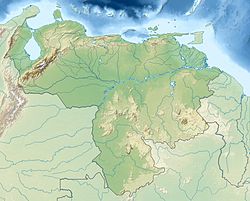| Angasima-tepui | |
|---|---|
| Highest point | |
| Elevation | 2,250 m (7,380 ft)[1] |
| Coordinates | 05°02′51″N 62°06′44″W / 5.04750°N 62.11222°W |
| Geography | |
| Location | Bolívar, Venezuela |
Angasima-tepui, also known as Adanta,[2] Adankasima or Adankachimö,[3][4] is a tepui in Bolívar state, Venezuela.[1] A relatively isolated peak, both it and nearby Upuigma-tepui lie just south of the vast Chimantá Massif, from which they are separated by the Río Aparurén valley. Amurí-tepui, the closest member of the Chimantá Massif, is only 8 kilometres (5.0 mi) from Angasima-tepui.[1]
The imposing triangular peak of Angasima-tepui has an elevation of around 2,250 metres (7,400 ft). Its summit plateau is heavily windswept, the northern part being dominated by low herbaceous vegetation. A southern peak bears dense tepui scrub. The mountain has a summit area of 2 km2 (0.77 sq mi) and an estimated slope area of 32 km2 (12 sq mi).[1] It is situated entirely within the bounds of Canaima National Park.[5]
The undescribed pitcher plant Heliamphora sp. 'Angasima Tepui' is endemic to the summit region of Angasima-tepui.[6]
See also
[edit]References
[edit]- ^ a b c d Huber, O. (1995). Geographical and physical features. In: P.E. Berry, B.K. Holst & K. Yatskievych (eds.) Flora of the Venezuelan Guayana. Volume 1. Introduction. Missouri Botanical Garden Press, St. Louis. pp. 1–61.
- ^ Señaris, C. & E. La Marca (2004). Stefania satelles. IUCN Red List of Threatened Species.
- ^ (in Spanish) Peréz, C. (2011). El Adankachimö: el camino del danto. Río Verde 5: 113–122.
- ^ (in Spanish) Adankasima Archived 2012-04-15 at the Wayback Machine. ClimTepuyes.
- ^ (in Spanish) Torres, I.N. & D.D. Martín (November 2007). "Informe Final de la Evaluación del Parque Nacional Canaima, Venezuela, como Sitio de Patrimonio Natural de la Humanidad" (PDF). Mejorando Nuestra Herencia.
- ^ McPherson, S., A. Wistuba, A. Fleischmann & J. Nerz (2011). Sarraceniaceae of South America. Redfern Natural History Productions, Poole.
Further reading
[edit]- (in Spanish) Brewer-Carías, C. (2010). El origen de los tepuyes: los hijos de las estrellas. Río Verde 3: 54–69.
- Kok, Philippe J.R.; MacCulloch, Ross D.; Means, D. Bruce; Roelants, Kim; Van Bocxlaer, Ines; Bossuyt, Franky (2012). "Low genetic diversity in tepui summit vertebrates". Current Biology. 22 (15): R589 – R590. doi:10.1016/j.cub.2012.06.034. PMID 22877774.
- Pruski, J.F. (1989). Notes on the Compositae of the Guayana Highland—I. A new species of Stomatochaeta and the reduction of Guaicaia to Glossarion (Compositae: Mutisieae). Brittonia 41(1): 35–40. doi:10.2307/2807586
- Vegas-Vilarrúbia, T., S. Nogué & V. Rull (August 2012). Global warming, habitat shifts and potential refugia for biodiversity conservation in the neotropical Guayana Highlands. Biological Conservation 152: 159–168. doi:10.1016/j.biocon.2012.03.036
